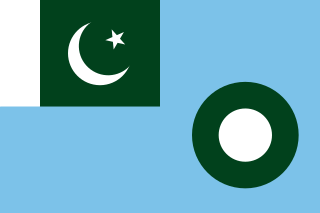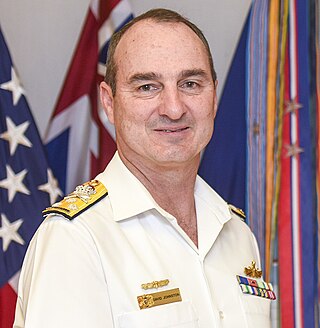
Marshal of the Royal Air Force (MRAF) is the highest rank in the Royal Air Force (RAF). In peacetime it was granted to RAF officers in the appointment of Chief of the Defence Staff (CDS), and to retired Chiefs of the Air Staff (CAS), who were promoted to it on their last day of service. While surviving Marshals of the RAF retain the rank for life, the highest rank to which officers on active service are promoted is now air chief marshal. Although general promotions to Marshal of the Royal Air Force have been discontinued since the British defence cuts of the 1990s, further promotions to the rank may still be made in wartime, for members of the Royal Family and certain very senior RAF air officers in peacetime at the discretion of the monarch; all such promotions in peacetime are only honorary, however. In 2012, the then Prince of Wales was promoted to the rank in recognition of his support for his mother, Queen Elizabeth II, in her capacity as head of the armed forces (commander-in-chief), while in 2014 Lord Stirrup, who had served as Chief of the Air Staff and Chief of the Defence Staff for over seven years, was also promoted.
Air marshal is an air-officer rank used by some air forces, with origins from the Royal Air Force. The rank is used by the air forces of many countries which have historical British influence, including many Commonwealth nations. The rank is usually equivalent to a vice admiral or a lieutenant general.
Air chief marshal is a high-ranking air officer rank used by some air forces, with origins from the Royal Air Force. The rank is used by air forces of many countries that have historical British influence. This rank is also equivalent to an Admiral in a navy or a full general in an army or other nations' air forces.
The Defence Strategic Policy and Intelligence Group (SP&I) of the Australian Government Department of Defence is responsible for defence diplomacy, strategic policy, international security, and military intelligence co-ordination and advice to the Prime Minister of Australia, Minister for Defence, Secretary of the Department of Defence, and Chief of the Defence Force. The Defence Strategic Policy and Intelligence Group is led by the Deputy Secretary for Strategic Policy and Intelligence and comprises three policy divisions and two intelligence agencies.

The United Kingdom's Strategic Command (StratCom), previously known as Joint Forces Command (JFC), manages allocated joint capabilities from the three armed services.
The Royal Australian Air Force is organised into a number of operational, support and training formations located at bases across Australia.
Chief of Air Force (CAF) is the most senior appointment in the Royal Australian Air Force (RAAF), responsible to the Chief of the Defence Force (CDF) and the Secretary of the Department of Defence. The rank associated with the position is air marshal (three-star). The role encompasses "the delivery of aerospace capability, enhancing the Air Force's reputation and positioning the Air Force for the future". It does not include direction of air operations, which is the purview of the Air Commander Australia, a two-star position responsible directly to CDF in such circumstances but nominally reporting to CAF.

The Chief of the Defence Force (CDF) is the highest-ranking and most senior military officer in the Australian Defence Force (ADF) and is the principal military advisor to the National Security Committee and the Minister for Defence. The current Chief of the Defence Force is Admiral David Johnston, who took office on 10 July 2024.
Defence Australia is a department of the Government of Australia charged with the responsibility to defend Australia and its national interests. Along with the Australian Defence Force (ADF), it forms part of the Australian Defence Organisation (ADO) and is accountable to the Commonwealth Parliament, on behalf of the Australian people, for the efficiency and effectiveness with which it carries out the Government's defence policy.

Air Chief Marshal Sir Neville Patrick McNamara, was a senior commander of the Royal Australian Air Force (RAAF). He served as Chief of the Air Staff (CAS), the RAAF's highest-ranking position, from 1979 until 1982, and as Chief of the Defence Force Staff (CDFS), Australia's top military role at the time, from 1982 until 1984. He was the second RAAF officer to hold the rank of air chief marshal.

The Vice Chief of the Defence Force (VCDF) is the military deputy to the Chief of the Defence Force (CDF) of Australia, and acts as the CDF in his absence under standing acting arrangements. Air Marshal Robert Chipman, the incumbent VCDF, has held the position since 9 July 2024.

The Chief of the Air Staff is a military appointment and a statutory office held by an Air Chief Marshal in the Pakistan Air Force, who is appointed by the Prime Minister of Pakistan and final confirmation by the President of Pakistan. The CAS is the highest-ranking officer of the Pakistan Air Force and only pilots are appointed in this post.

The Australian Defence Force Investigative Service (ADFIS) is the unified investigative arm of the Australian Defence Force's Joint Military Police Unit. Initially formed in 2007 as a part of the service police until its amalgamation into the Joint Military Police Force at the beginning of 2020. ADFIS was responsible for complex and major disciplinary and criminal investigations involving the Australian Defence Force (ADF), its assets, land, personnel and capability.
The Australian Defence Organisation (ADO) is composed of the armed forces of the Commonwealth of Australia, the Australian Defence Force (ADF), and the Australian Public Service government department, the Department of Defence which is composed of a range of civilian support organisations.

The National Defence College, located in New Delhi, is the defence service training institute and highest seat of strategic learning for officers of the Defence Service and the Civil Services. This is a very prestigious course attended only by a few hand-picked defence officers of One-Star rank and civil servants of the rank of Joint secretary to the Government of India. Each year, approximately 25 officers from friendly foreign countries like the US, UK, Canada, France, Germany, Australia, Vietnam, Sri Lanka, Nepal, UAE and others attend the course.

The Navy Command is the current headquarters body of the Royal Navy, and as of 2012 its major organisational grouping. It is a hybrid, neither a command, nor simply an installation. Royal Navy official writings describe Navy Command Headquarters both as a physical site, on Whale Island, Hampshire, a collective formed of the most senior RN officers, and as a budgetary grouping.
Rear Admiral Trevor Norman Jones, is a retired senior officer in the Royal Australian Navy (RAN). He served as Deputy Chief of Navy from 2011 to 2013, Head Military Strategic Commitments from April 2013 to December 2014, and the Commander Joint Task Force 633 from December 2014 to January 2016.

Admiral David Lance Johnston, is a senior officer in the Royal Australian Navy. He served as Deputy Commander Joint Task Force 633 on Operation Slipper in 2010, Commander Border Protection Command from 2011 to 2013 and, following promotion to vice admiral, was posted as Chief of Joint Operations from 2014 until 2018. Johnston was appointed Vice Chief of the Defence Force in July 2018. He was promoted to admiral and appointed Chief of the Defence Force on 10 July 2024.

The Joint Military Police Unit is the unified military police agency of the Australian Defence Force. The Joint Military Police Unit is led by the Provost Marshal who reports to the Chief of Joint Capabilities responsible for general policing, law enforcement, and the Australian Defence Force Investigative Service.
Air Marshal Warren George McDonald, is a retired senior officer of the Royal Australian Air Force (RAAF). He joined the RAAF as a 15-year-old apprentice and, in 1989, underwent pilot training. A series of squadron and staff postings in Australia, Canada and Malaysia followed, before he was appointed to command No. 11 Squadron (2007–09), No. 92 Wing (2009–11) and Air Mobility Group (2013–15). He was Deputy Chief of Air Force from July 2015 to May 2017 and the inaugural Chief of Joint Capabilities from July 2017 to November 2020.











